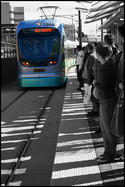Laura Jean Berger worked on the Congressional Campaign of Assemblyman Van Tran. This is her account of the results.
Energy and free beer flowed through Assemblyman Van Tran's campaign headquarters, the crowd anxiously building with anticipation each time Fox News reported another House seat for the Republicans. Every major network's live trucks crowded the parking lot of the converted Blockbuster video store, their cameras trained on a stage set for a victory speech. read more »






















